Birdfinding.info ⇒ Widespread and common across most of Eurasia’s open spaces from the arctic to subtropical deserts and from Ireland, Portugal, and Morocco to Japan, Kamchatka, and the Bering Sea. Introduced populations are common across Victoria and adjacent areas of southeastern Australia, and throughout New Zealand. In Hawaii, it is common on Maui around Haleakala National Park and Polipoli Spring, and on the Big Island: e.g., Waikoloa Village, Waiki’i Ranch, Pu’u La’au, and South Point. The small British Columbia population is found mainly on the Saanich Peninsula around the Victoria Airport, and in fields along Central Saanich and Island View Roads.
Eurasian Skylark
Alauda arvensis
Family: Alaudidae
Grasslands of Eurasia.
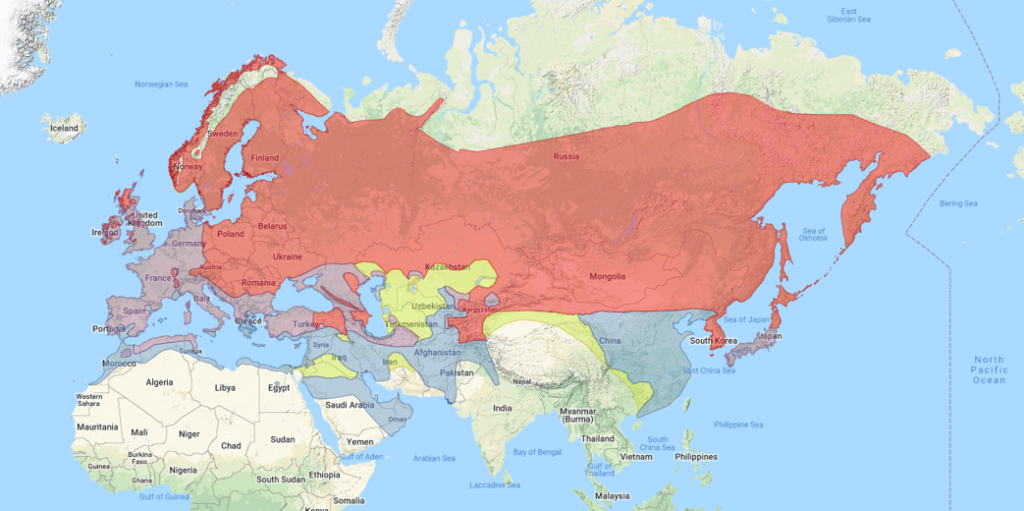
Approximate natural range of the Eurasian Skylark. © Xeno-Canto 2021
Sometimes regarded as comprising three distinct forms, one mostly European, one pan-Asian, and one limited to Japan, Korea, coastal China, southeastern Russia, and nearby islands—although the basis for these subdivisions is not clear as they overlap geographically and do not appear to be readily distinguishable. In this arrangement, the forms would be distributed approximately as follows:
“European Skylark” (arvensis, scotica, guillelmi, sierrae, harterti, cantarella, and armenica): breeds throughout the western Palearctic from northern Norway and the Faeroe Islands east to the Urals and south to the mountains of northwestern Africa (Morocco to Tunisia), several Mediterranean islands, and southwestern and northeastern Iran.
Partly migratory: in winter northern and eastern populations mostly withdraw from Scandinavia, Russia, and eastern Europe, and move into the general Mediterranean region and Middle East from the Canary Islands east to the Arabian Peninsula and Iran.
Spring migrants regularly overshoot to Iceland. Both northbound and southbound migrants occasionally reach the Azores and Madeira, sometimes in large flocks.
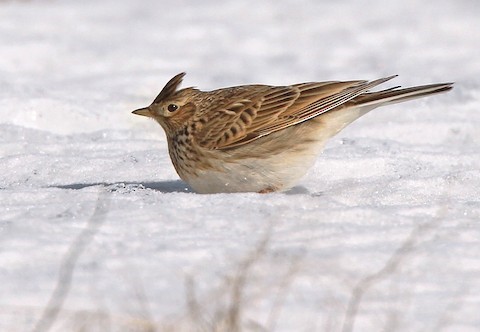
“European Skylark”, A. a. arvensis, is one of very few insectivores hardy enough to survive winter in Scandinavia. (Galtabäcks Skär, Sweden; March 15, 2010.) © Lars Petersson
Introduced populations are established across southeastern Australia (Victoria north to the Sydney area and west to coastal South Australia), Tasmania, New Zealand, the Chatham Islands, the main Hawaiian Islands (all except Kauai), and southwestern British Columbia on southern Vancouver Island (and sometimes also on San Juan Island in Washington State). These are thought to have resulted primarily from transplants of arvensis, but introductions of other subspecies may have occurred in some areas.
“Asian Skylark” (pekinensis, lonnbergi, kiborti, and dulcivox): breeds on open plains from the Volga River Valley of south-central Russia and Kazakhstan east to the Bering Sea coastline (to Anadyr), Kamchatka, and the Kurile Islands, south to northern Afghanistan, northernmost Pakistan, western and northeastern China, and the base of the Korean Peninsula.
Highly migratory: western (i.e., central Asian) populations winter across Afghanistan, Pakistan, and northwestern India—likely also on the Arabian Peninsula. Eastern populations winter mainly in central and eastern China—and possibly also Korea, Japan, and Taiwan.
Spring migrants annually overshoot to Alaska’s Bering Sea islands and have bred on the Pribilofs and likely on the outer Aleutian.
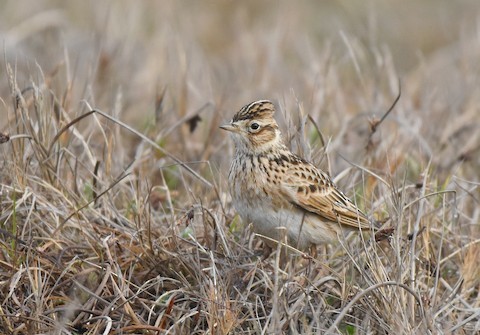
“Asian Skylark”, A. a. pekinensis, is highly migratory and sometimes wanders to the Pacific Coast of North America. (Lake Tolowa, California; January 3, 2019.) © Christopher Lindsey
Fall vagrants have been recorded in western North America: but in south-coastal Alaska, Oregon, and California. There are also multiple records from the Northwest Chain of Hawaii. In Asia, fall overshoots have been recorded in Singapore and Sabah.
“Japanese Skylark” (japonica and intermedia): breeds throughout Japan and on Sakhalin, the southern Kurile Islands, the Korean Peninsula, Jeju Island, and adjacent coastal areas of southeastern Russia and northwestern China.
Winters in central and southern Japan, the Ryukyu Islands, Taiwan, and southeastern China.
Identification
The generic lark: a plain songbird with streaked brown upperparts and whitish underparts.
Often shows a peaked crest, but when these feathers are not raised its head appears flat-topped or rounded.

Eurasian Skylark. (Salcedo, Asturias, Spain; December 20, 2013.) © Luis Mario Arce
The streaking on the upperparts is typically blackish or dark-brown on a pale-brown base. The streaking is especially dense and well-defined on the crown and back, and also continues as a necklace of streaks across the chest.
The facial pattern is dominated by a buffy or brownish cheek and auricular patch, bordered by a pale eyebrow which merges into an indistinct pale eyering. The throat is typically unstreaked and whitish.
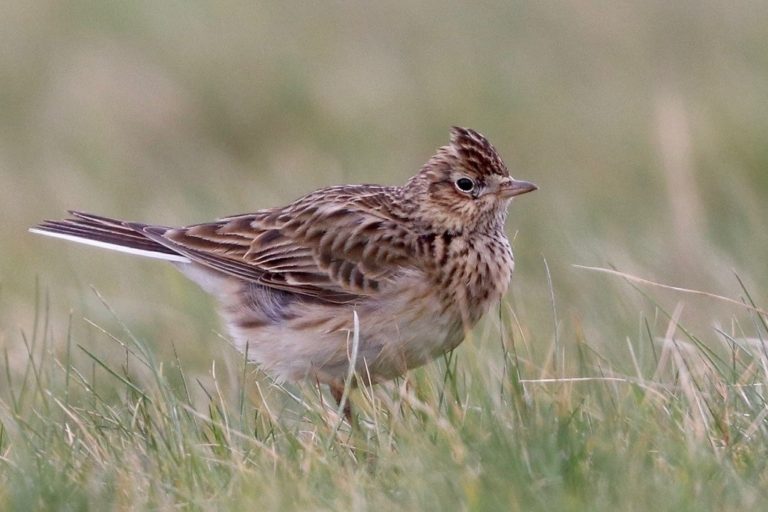
Eurasian Skylark, A. a. arvensis. (Lunderskov, Denmark; March 2, 2020.) © Gitte Langgaard Jensen
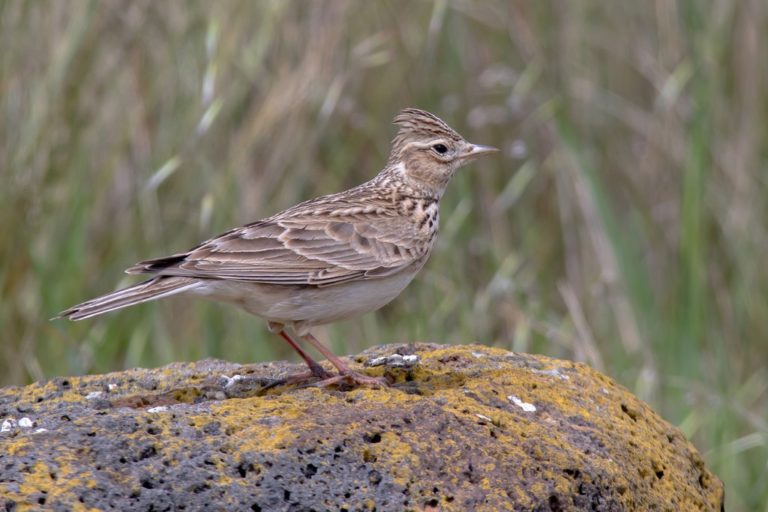
Eurasian Skylark. (Western Treatment Plant, Wyndham, Victoria, Australia; October 6, 2017.) © Andrew Allen

Eurasian Skylark, A. a. guillelmi, a boldly patterned individual, showing its white outer tail feathers. (Lagunas, Segovia, Castilla y León, Spain; June 8, 2018.) © César Diez González
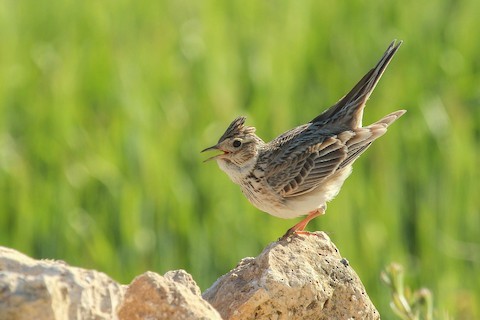
Eurasian Skylark, A. a. guillelmi, singing from a low perch. (Las Quintanillas, Burgos, Castilla y León, Spain; May 18, 2020.) © César Diez González

Eurasian Skylark, A. a. sierrae. (Arouca, Portugal; June 1, 2019.) © naturepel

Eurasian Skylark, A. a. arvensis. (Shingle Street, Suffolk, England; May 20, 2020.) © Peter Kennerley
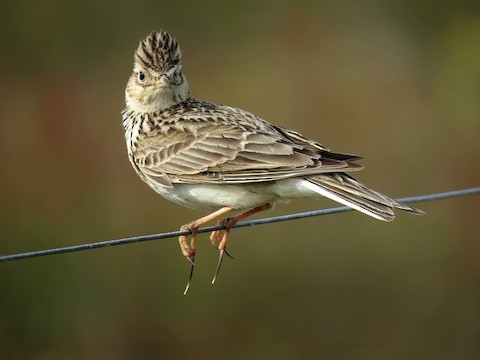
Eurasian Skylark, A. a. arvensis, showing its heavily streaked crown, white outer tail-feathers, and extra-long hind-claws. (Rye Harbour Nature Reserve, East Sussex, England; June 2, 2019.) © Nick Smith
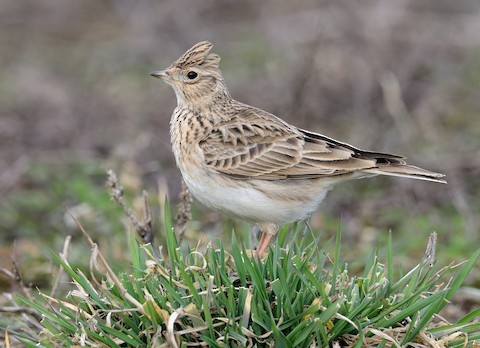
Eurasian Skylark, A. a. arvensis, a pale individual. (Pohořelice, Jihomoravský Kraj, Czechia; February 22, 2020.) © Pavel Štěpánek
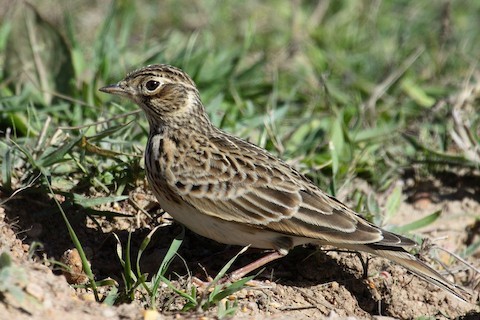
Eurasian Skylark, with crest held flat, showing typical pattern and coloration. (Sagres, Portugal; November 3, 2010.) © António Gonçalves
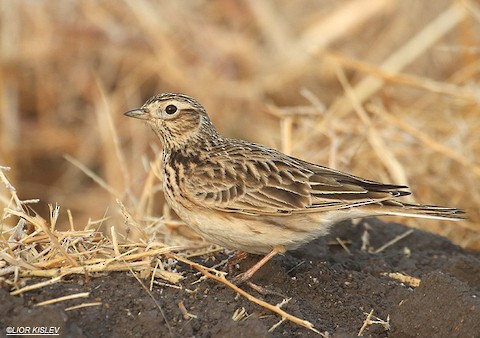
Eurasian Skylark, likely A. a. cantarella or dulcivox, with bold facial pattern. (Valley of Springs, HaZafon, Israel; November 18, 2010.) © Lior Kislev
The outer tail feathers are white. In flight, the trailing edge of the wing is also white—broadest on the secondaries and noticeable mostly on the upperside.
The bill is sturdy, slightly decurved, and mostly pale but usually has a dark ridge and tip.
The legs are usually pinkish and the hind-toe has an inordinately long claw (a feature it shares with many other lark species). However, leg color is remarkably variable, and can also be orange, yellow, or black.
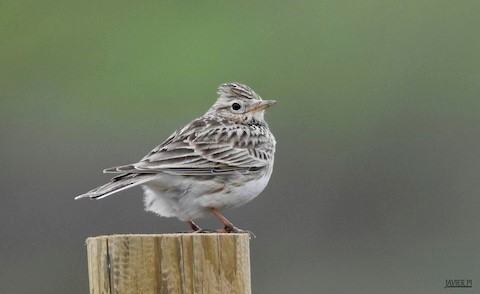
Eurasian Skylark, A. a. guillelmi. (Fuentesblancas, Burgos, Castilla y León, Spain; April 30, 2018.) © Javier Pi Vallina

Eurasian Skylark, A. a. arvensis or cantarella. (Okanj Lake, Vojvodina, Serbia; March 12, 2020.) © Mira Milovanović

Eurasian Skylark, A. a. arvensis, a rusty individual. (Rainham, England; October 21, 2016.) © Dominic Mitchell
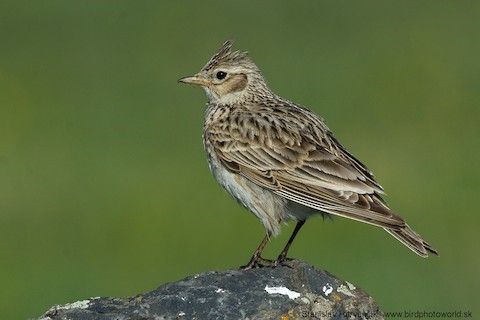
Eurasian Skylark, A. a. armenica, with blackish legs. (Aragatsotn, Armenia; May 13, 2019.) © Stanislav Harvančík
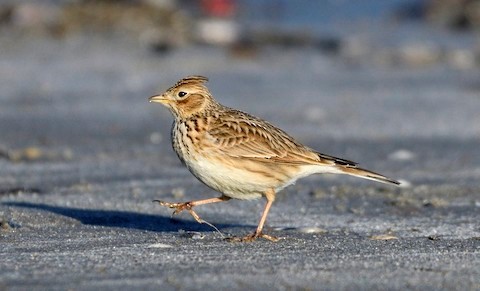
Eurasian Skylark, A. a. scotica. (Bull Island, Dublin, Ireland; March 8, 2018.) © Tomáš Grim
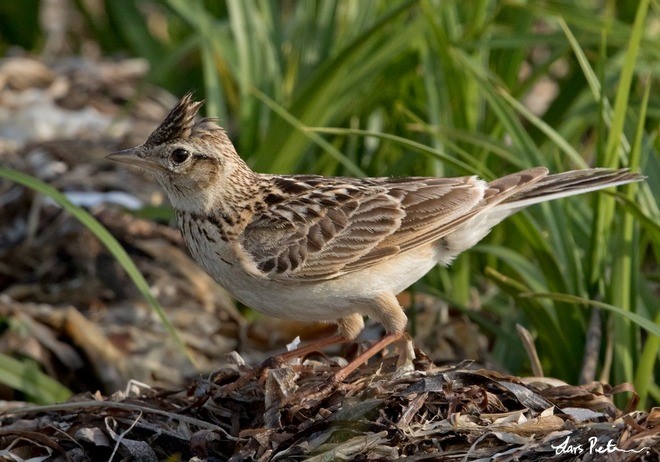
“Japanese Skylark”, A. a. japonica. (Lake Furen, Hokkaido, Japan; June 10, 2017.) © Lars Petersson
Regional Variation. Populations vary in the tones of their plumage—but these variations do not appear to correspond closely to the subdivisions among forms that are sometimes recognized (i.e., “European”, “Asian”, and “Japanese”).
Skylark populations from southern and eastern Europe to central Asia (e.g., cantarella, armenica, and dulcivox) tend to be paler than others. Those of eastern Asia (e.g., pekinensis, lonnbergi, and japonica) tend to be darker overall, with warmer shades of brown. Those of northern and western Europe (e.g., scotica and arvensis) tend to be intermediate. However, each region or population seems to include representatives from across the spectrum of plumage tones.
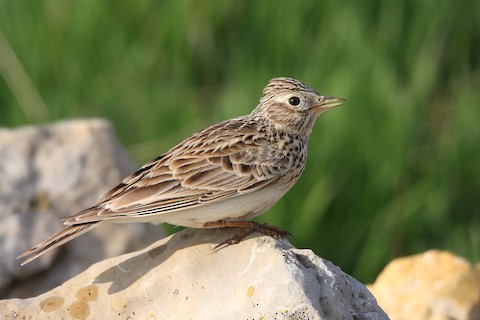
Eurasian Skylark, A. a. guillelmi. (Valladolid, Castilla y León, Spain; April 20, 2012.) © Carlos Bocos
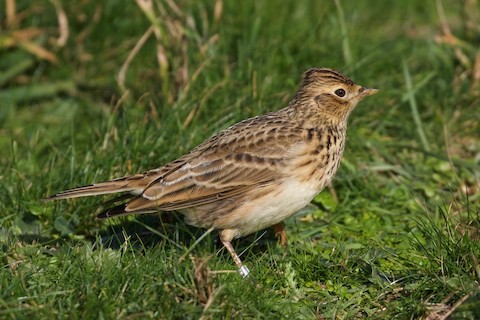
Eurasian Skylark. (Helgoland, Germany; October 15, 2020.) © Thomas Doebel
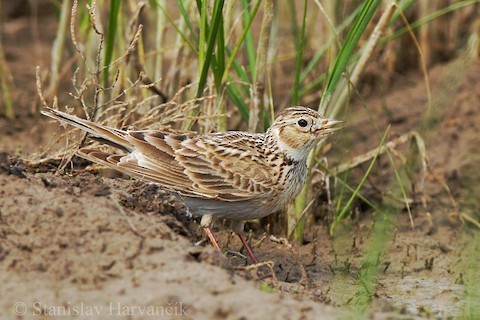
“Asian Skylark”, A. a. dulcivox. (Korgalzhyn State Nature Reserve, Aqmola Oblysy, Kazakhstan; May 15, 2012.) © Stanislav Harvančík
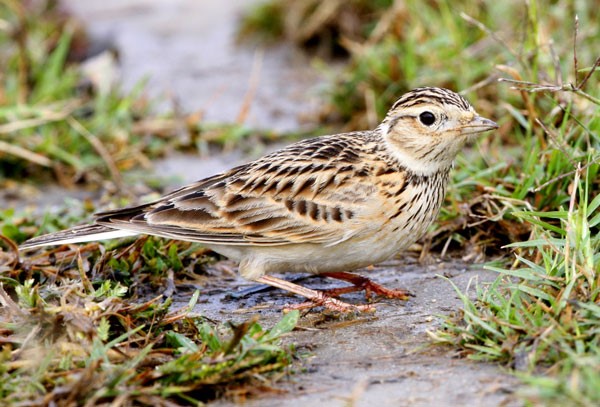
“Asian Skylark”, A. a. pekinensis (or possibly “Japanese Skylark”, A. a. intermedia). (Hong Kong; February 9, 2010.) © Martin Hale
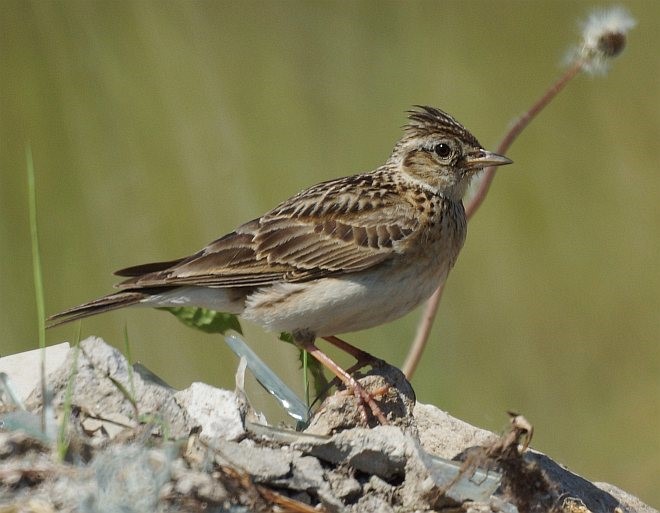
“Asian Skylark”, A. a. pekinensis. (Komsomolsk-on-Amur, Khabarovsk Region, Russia; June 27, 2017.) © Nikolay Loginov

“Asian Skylark”, A. a. dulcivox. (Nagrota Surian, Pong Lake, Himachal Pradesh, India; December 27, 2017.) © Ritvik Singh

Eurasian Skylark, A. a. cantarella. (Saklıkent, Antalya, Turkey; June 14, 2020.) © Güneş Deniz Yildrim
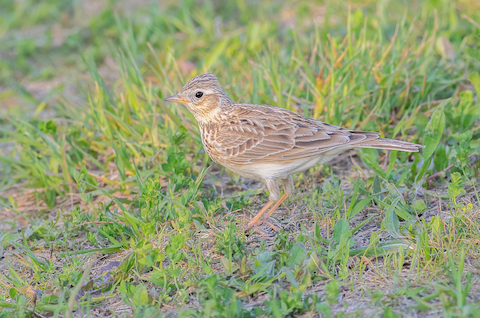
Eurasian Skylark, A. a. arvensis, a notably pale individual. (Trumpington, Cambridgeshire, England; May 7, 2020.) © Daniel Field
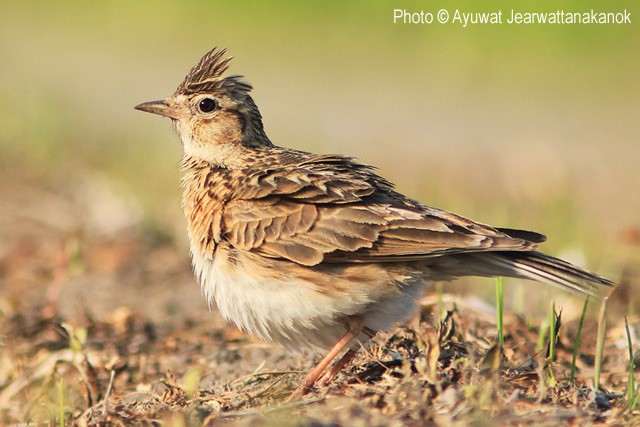
“Japanese Skylark”, A. a. japonica. (Bungo-Kokubu, Oita, Kyushu, Japan; May 5, 2013.) © Ayuwat Jearwattanakanok

Eurasian Skylark, A. a. sierrae. (Portas do Mouchão da Cabra, Portugal; April 3, 2018.) © Teresa Cohen
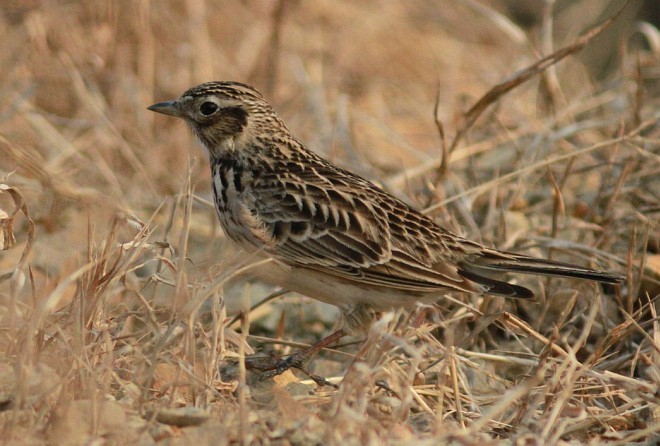
“Asian Skylark”, A. a. kiborti, a dark, heavily streaked individual. (Jinshitan, Dalian, Liaoning, China; March 22, 2014.) © Tom Beeke
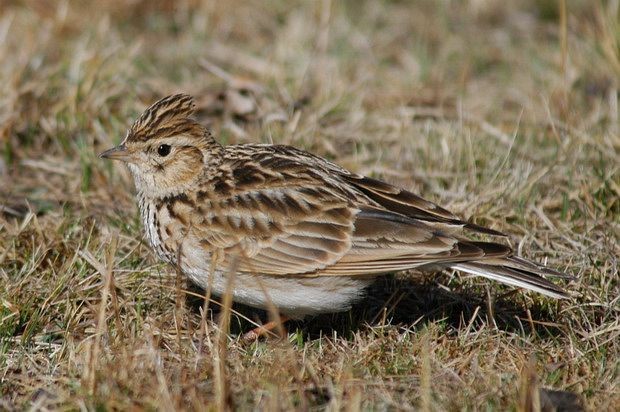
“Asian Skylark”, A. a. kiborti. (Ruoergai Marshes, Sichuan, China; April 24, 2006.) © David Blank

Eurasian Skylark, A. a. guillelmi. (Lago de Sanabria, Castilla y León, Spain; June 26, 2015.) © Miguel Rodríguez Esteban

“Asian Skylark”, A. a. pekinensis (or possibly “Japanese Skylark”, A. a. intermedia). (Hong Kong; February 9, 2010.) © Martin Hale

“Asian Skylark”, A. a. dulcivox. (Basai Wetland, Gurgaon, Haryana, India; June 18, 2018.) © Kavi Nanda

“Japanese Skylark”, A. a. japonica. (Uno, Okayama, Honshu, Hokkaido, Japan; June 27, 2017.) © Oscar Moss
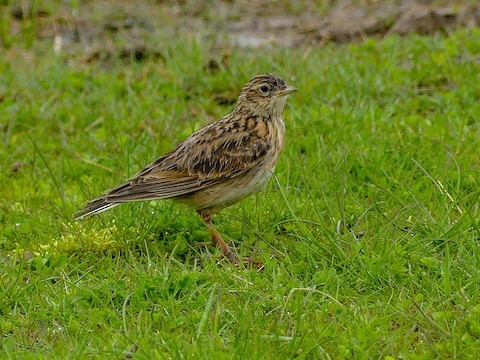
Eurasian Skylark, A. a. arvensis. (Frampton Marsh RSPB Reserve, Lincolnshire, England; May 2, 2018.) © Mike Prince
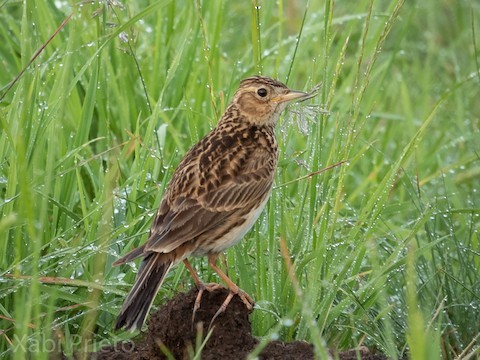
Eurasian Skylark, A. a. guillelmi. (Costa da Zapateira, Lugo, Galicia, Spain; June 20, 2020.) © Xabier Prieto Espiñeira

Eurasian Skylark. (Karajukića Bunari, Raška, Serbia; May 2, 2011.) © Vladan Vuckovic
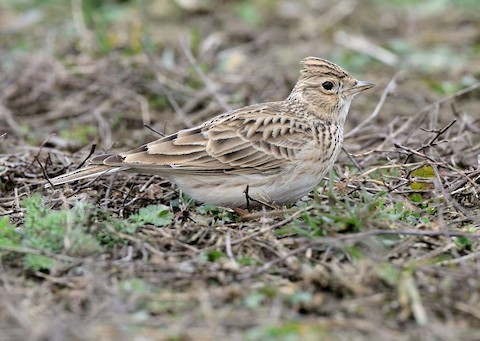
Eurasian Skylark, A. a. arvensis, with pale sandy-brown upperparts. (Pohořelice, Jihomoravský Kraj, Czechia; February 22, 2020.) © Pavel Štěpánek
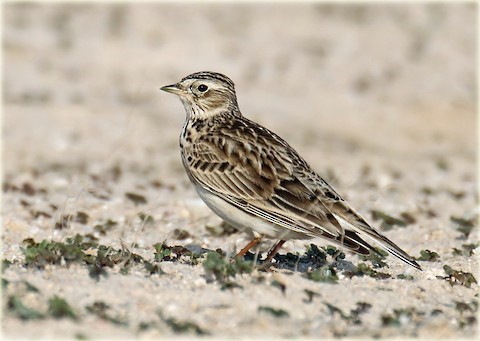
Eurasian Skylark. (Arakhiya Farm, Jariyan al Batnah, Qatar; December 18, 2011.) © John Thompson
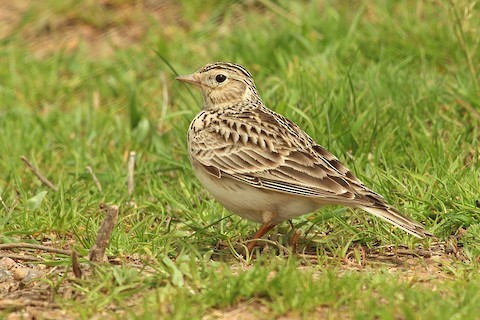
Eurasian Skylark, A. a. guillelmi. (Fuentesblancas, Burgos, Castilla y León, Spain; April 30, 2018.) © César Diez González

“Asian Skylark”, A. a. pekinensis (or possibly “Japanese Skylark”, A. a. intermedia), with boldly patterned, warm-brown upperparts. (Hong Kong; February 9, 2010.) © Martin Hale
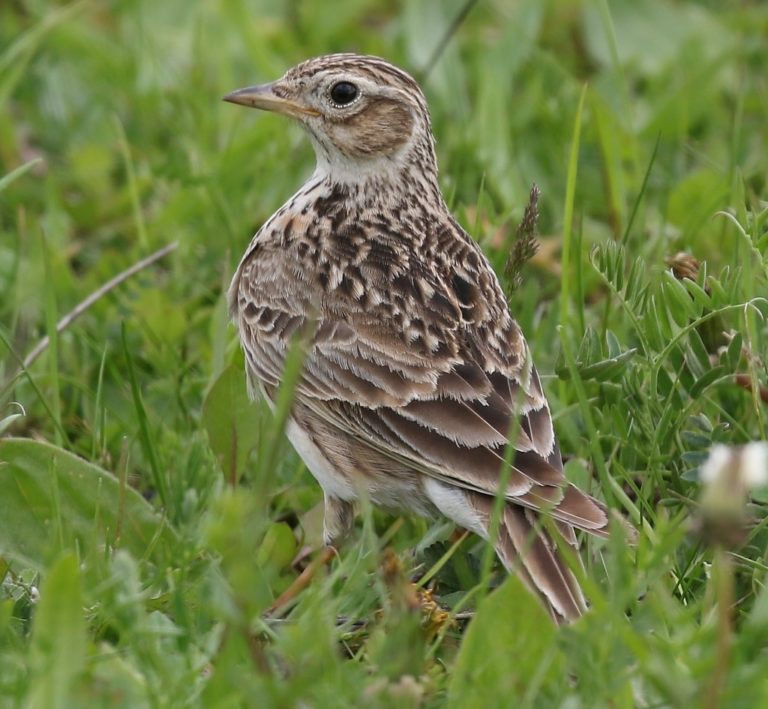
Eurasian Skylark, A. a. arvensis. (Otok, Slovenia; May 8, 2019.) © Luca Boscain
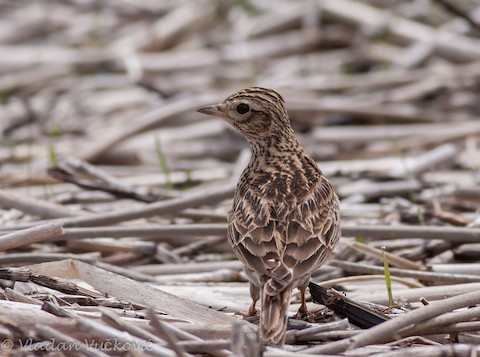
“Japanese Skylark”, A. a. japonica, with mostly dark upperparts. (Chofu, Tokyo, Honshu, Japan; May 5, 2018.) Anonymous eBirder

Eurasian Skylark, A. a. arvensis, showing heavily streaked upperparts from the crown to the tail. (Topolovgrad, Haskovo, Bulgaria; February 12, 2015.) © Simeon Gigov

“Asian Skylark”, A. a. pekinensis (or possibly “Japanese Skylark”, A. a. intermedia). (Hong Kong; October 22, 2010.) © Martin Hale
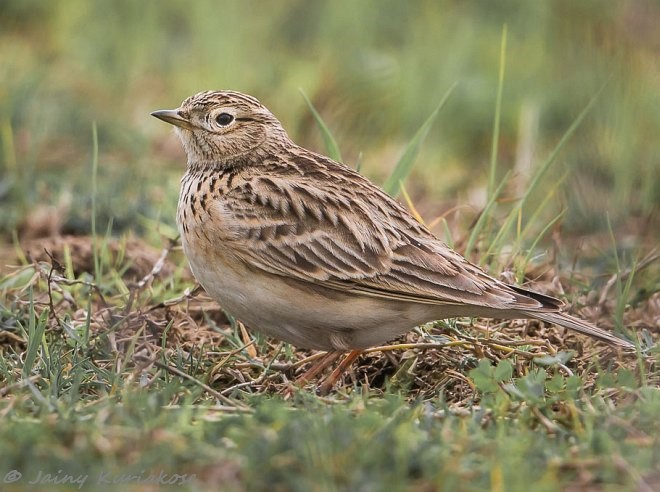
“Asian Skylark”, A. a. dulcivox. (Pong Lake, Himachal Pradesh, India; February 19, 2015.) © Jainy Kuriakose
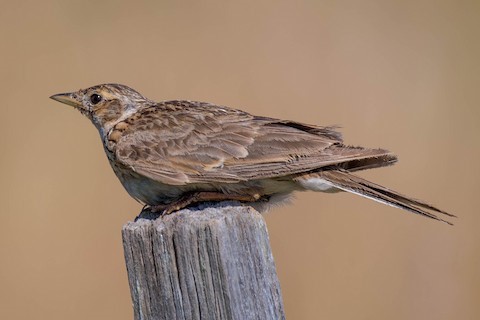
Eurasian Skylark with atypical lack of streaking over most of upperparts. (Harford, Latrobe, Tasmania, Australia; January 14, 2019.) © Terence Alexander
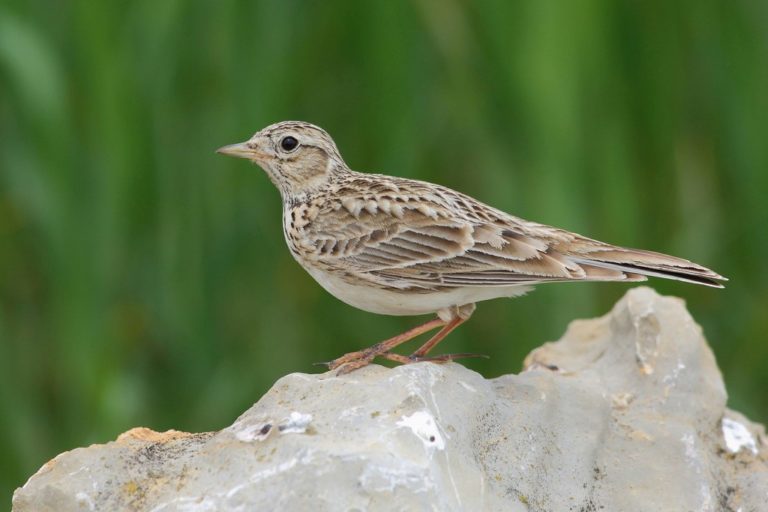
Eurasian Skylark, A. a. guillelmi. (Valladolid, Castilla y León, Spain; May 6, 2016.) © Carlos Bocos
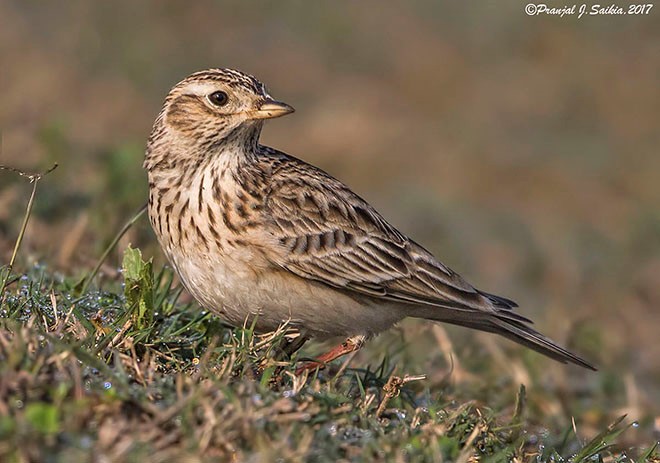
“Asian Skylark”, A. a. dulcivox. (Nagrata Surian, Pong Lake, Himachal Pradesh, India; February 12, 2017.) © Pranjal J. Saikia
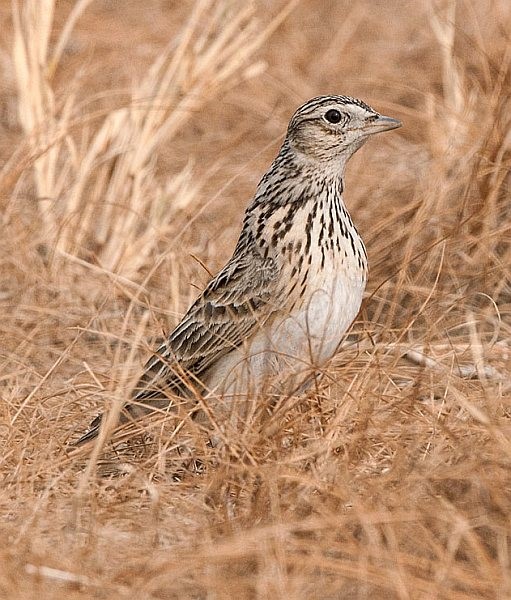
“Asian Skylark”, A. a. dulcivox. (Tal Chappar Wildlife Sanctuary, Churu, Rajasthan, India; January 1, 2012.) © Nikhil Devasar
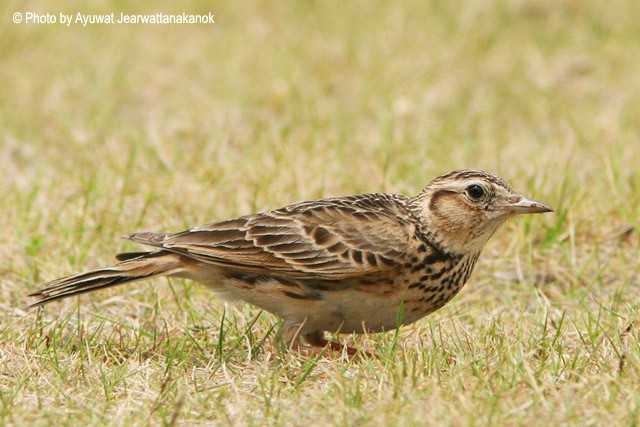
“Japanese Skylark”, A. a. japonica, with a bold black necklace of streaks. (Beppu, Oita, Kyushu, Japan; May 4, 2008.) © Ayuwat Jearwattanakanok
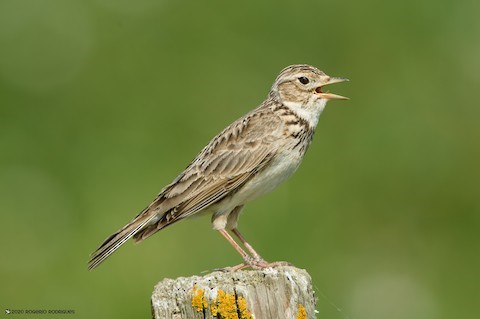
Eurasian Skylark, A. a. sierrae. (Portas do Mouchão da Cabra, Portugal; March 12, 2020.) © Rogério Rodrigues
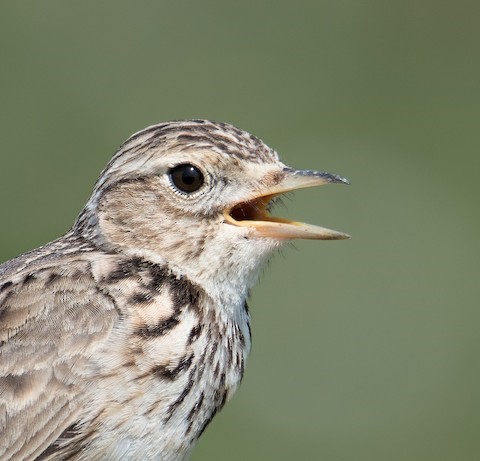
Eurasian Skylark, A. a. sierrae. (Portas do Mouchão da Cabra, Portugal; March 12, 2020.) © Rui Pereira

Eurasian Skylark, A. a. guillelmi. (Embalse de Cernadilla, Zamora, Castilla y León, Spain; May 25, 2020.) © Manuel Segura Herrero
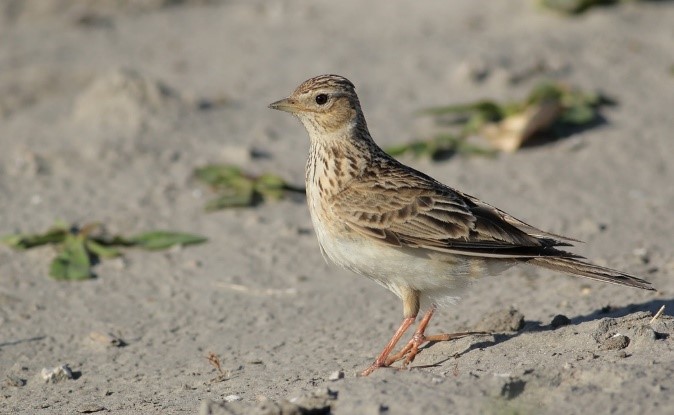
Eurasian Skylark, A. a. arvensis, with fine streaks on the chest. (Loon-Plage, France; June 14, 2017.) © admss
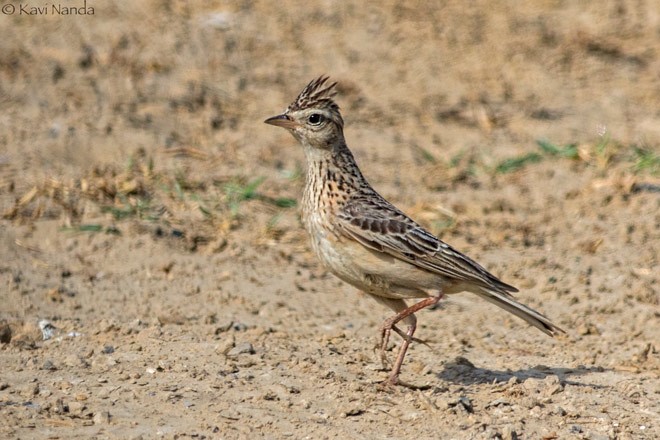
“Asian Skylark”, A. a. dulcivox. (Basai Wetland, Gurgaon, Haryana, India; June 18, 2018.) © Kavi Nanda
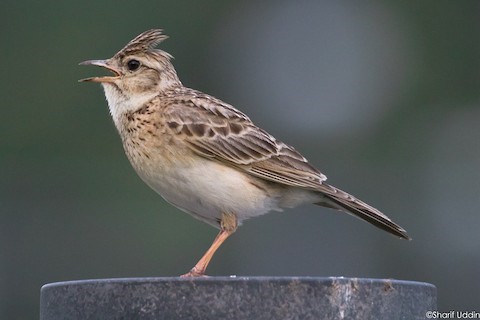
“Japanese Skylark”, A. a. japonica. (Nara, Honshu, Japan; June 13, 2016.) © Sharif Uddin
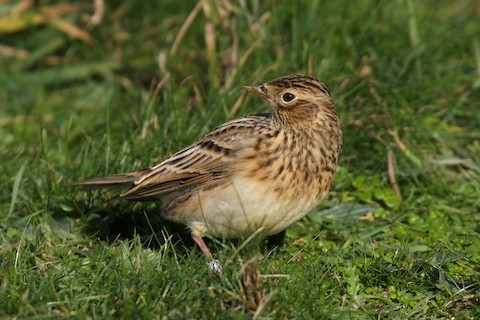
Eurasian Skylark. (Helgoland, Germany; October 15, 2020.) © Thomas Doebel
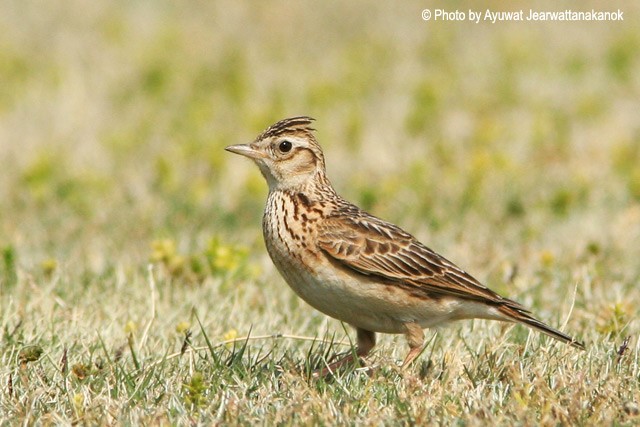
“Japanese Skylark”, A. a. japonica, with fine streaks on the chest. (Beppu, Oita, Kyushu, Japan; April 26, 2008.) © Ayuwat Jearwattanakanok
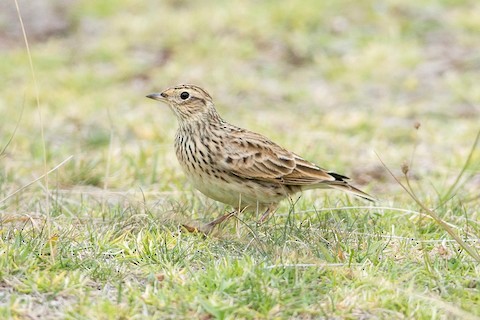
Eurasian Skylark. (Halemau’u Trail, Haleakala National Park, Maui, Hawaii; October 8, 2019.) © Lucas Berrigan

Eurasian Skylark, A. a. arvensis. (Loon op Zand, Netherlands; April 11, 2012.) © Paul Cools

“Asian Skylark”, A. a. kiborti, with fine streaks on the chest. (Ruoergai Marshes, Sichuan, China; April 24, 2006.) © David Blank
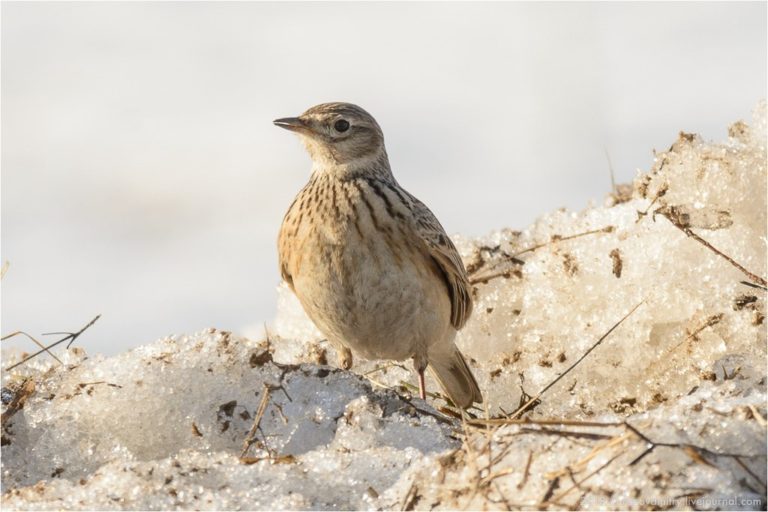
“Asian Skylark”, A. a. dulcivox. (Samarskaya Luka National Park, Samara, Russia; April 11, 2018.) © Ruzov Dmitry
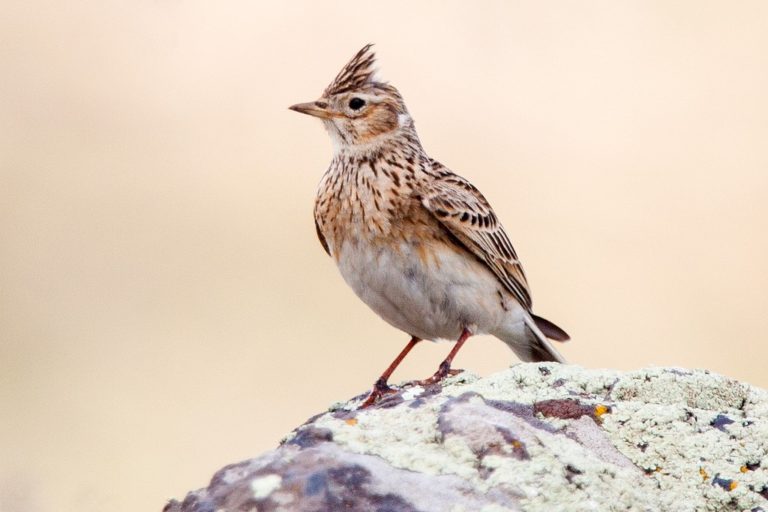
Eurasian Skylark, A. a. cantarella. (Aragatsotn, Armenia; May 26, 2011.) © Sergei Drovetski

Eurasian Skylark, A. a. cantarella, with a nearly unstreaked chest. (Aragatsotn, Armenia; May 24, 2014.) © Sergei Drovetski

Eurasian Skylark. (Cooee, Burnie, Tasmania, Australia; August 25, 2015.) © Alan Melville
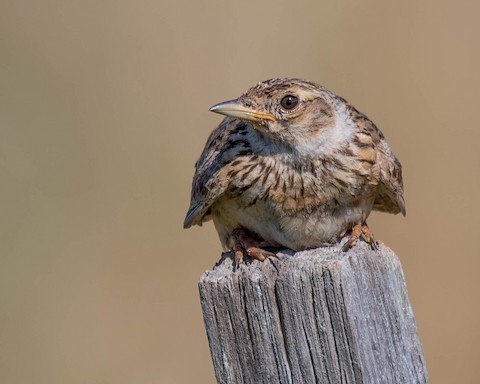
Eurasian Skylark, A. a. arvensis, with unusually gray throat and partial collar. (Harford, Latrobe, Tasmania, Australia; January 14, 2019.) © Terence Alexander

Eurasian Skylark, juvenile with exceptionally bright fresh plumage. (Moscow, Russia; June 24, 2018.) © Mikhail Ezdakov
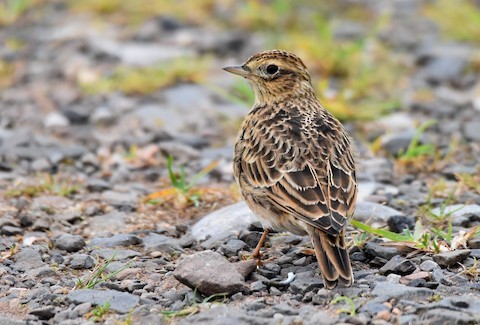
Eurasian Skylark, A. a. scotica, juvenile with typically bright fresh plumage. (Barns Ness, Scotland; September 20, 2020.) © Lukasz Pulawski
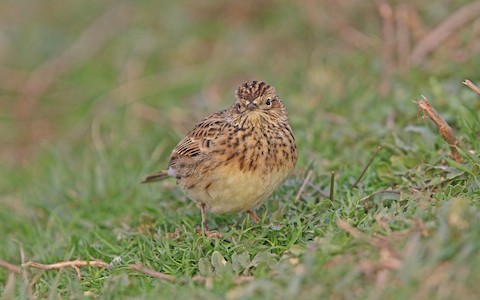
Eurasian Skylark, juvenile. (Helgoland, Germany; October 15, 2020.) © Christoph Moning

“Japanese Skylark”, A. a. japonica (or possibly “Asian Skylark”, A. a. pekinensis). (Notsuke Hanto, Hokkaido, Japan; September 19, 2004.) © Yann Muzika
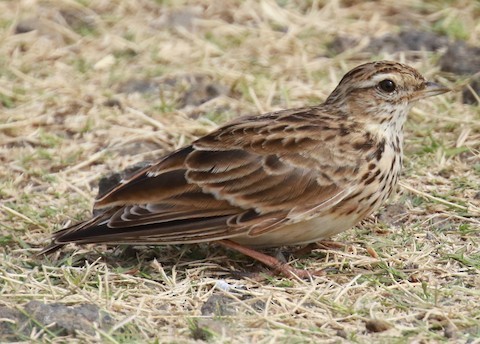
Eurasian Skylark, juvenile (or highly atypical adult). (South Point, Big Island, Hawaii; July 18, 2018.) © Jordan Roderick

Eurasian Skylark, A. a. arvensis, juvenile. (Dunwich Beach, Suffolk, England; August 29, 2018.) © Matthew Grube
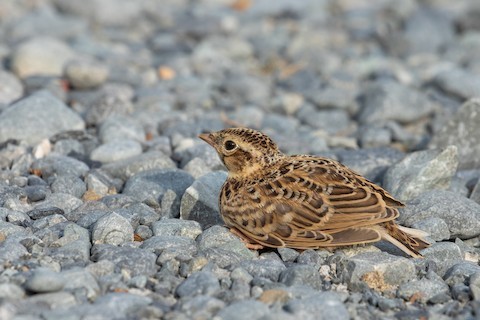
Eurasian Skylark, juvenile. (Black Stilt Refuge, Glentanner, South Island, New Zealand; January 10, 2020.) © Louis Bevier
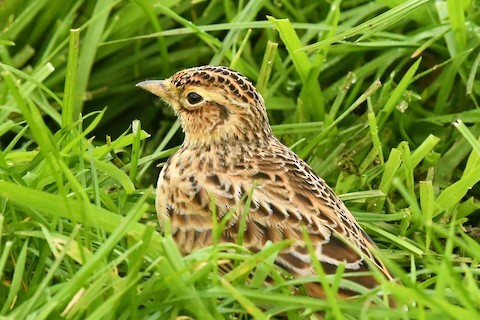
Eurasian Skylark, A. a. scotica, juvenile. (Omey Island, Galway, Ireland; October 13, 2020.) © Mike Sylvia
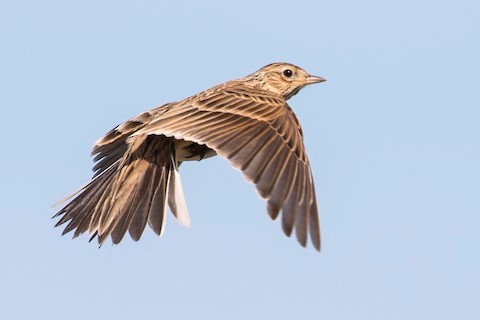
Eurasian Skylark, A. a. arvensis, showing white outer tail feather and trailing edge on secondaries and inner primaries. (Central Saanich, British Columbia; March 17, 2019.) © Liron Gertsman

Eurasian Skylark, A. a. arvensis, showing white trailing edge on secondaries and inner primaries. (Central Saanich, British Columbia; May 30, 2018.) © Isaac Sanchez
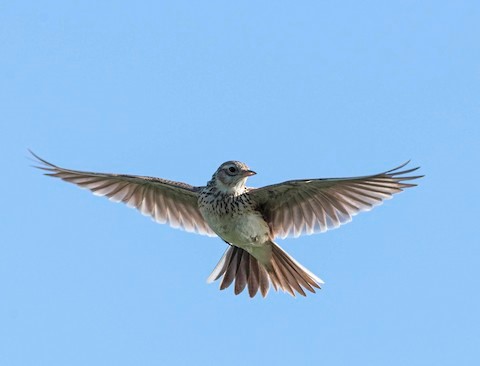
Eurasian Skylark, A. a. arvensis. (Oran Park, New South Wales, Australia; October 11, 2019.) © David Davidson
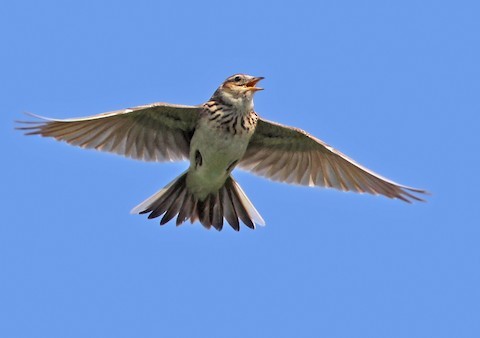
Eurasian Skylark, A. a. arvensis. (Jämjö, Öland, Sweden; May 10, 2010.) © Lars Petersson
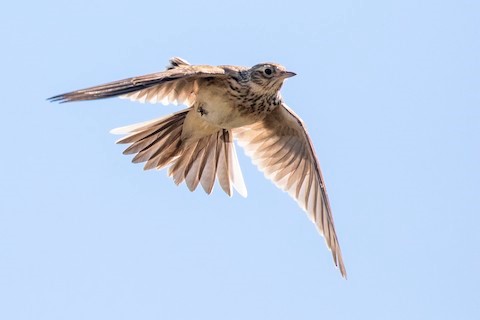
Eurasian Skylark, A. a. arvensis. (Central Saanich, British Columbia; March 17, 2019.) © Liron Gertsman

Eurasian Skylark, A. a. arvensis. (Central Saanich, British Columbia; March 17, 2019.) © Liron Gertsman

“Japanese Skylark”, A. a. japonica. (Bungo-Kokubu, Oita, Kyushu, Japan; May 5, 2013.) © Ayuwat Jearwattanakanok
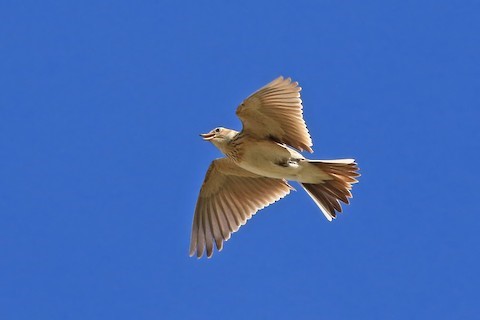
Eurasian Skylark, A. a. cantarella. (Durmitor National Park, Žabljak, Montenegro; April 23, 2018.) © Phillip Edwards
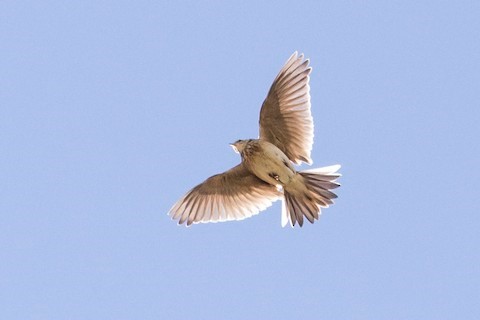
Eurasian Skylark, A. a. arvensis. (Central Saanich, British Columbia; March 17, 2019.) © Liron Gertsman
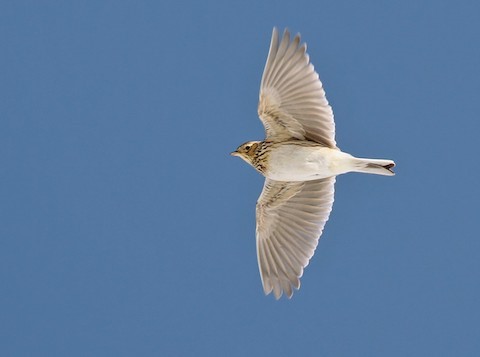
Eurasian Skylark, A. a. arvensis. (Galtabäcks Skär, Sweden; March 15, 2010.) © Lars Petersson
Cf. Oriental Skylark. Eurasian and Oriental Skylarks occur together over a long swath of Asia that stretches from Israel to Taiwan. The differences between them are subtle and somewhat variable.
In general, Eurasian is larger, proportionately longer-winged, and has whiter underparts and outer tail feathers, and a whiter trailing edge on the secondaries. Conversely, Oriental averages smaller (a.k.a. Small Skylark) with shorter primaries, buffier underparts and outer tail feathers, and less contrast on the trailing edge of the secondaries.
The songs are similar, although Oriental’s tends to be simpler, typically repeating identical notes or phrases many more times in a row than Eurasian. Many of their call notes are also similar, but Oriental is known to give a sharp buzzy burst in flight that seems to be unknown from Eurasian.
Cf. Woodlark. Eurasian Skylark and Woodlark occur together over much of Europe and western Asia. The two are fairly similar, but Woodlark is smaller, with shorter wings and tail, and usually occurs in woodlands, where it habitually perches on trees. Woodlark also differs in having dark outer tail feathers with white tips, and a bold white bar on the primary coverts—visible in flight on the upperside of the wing.
Cf. Crested and Thekla Larks. Eurasian Skylark overlaps with Crested Lark across a wide band of Eurasia from Portugal to Korea and with Thekla Lark throughout Thekla’s limited Mediterranean range. These species can be very similar, with Thekla roughly intermediate between the others.
Crested Lark differs from the Eurasian Skylark in that it has a taller crest, proportionately longer bill, less distinct markings on the upperparts, rusty outer tail feathers, a rusty tone on the underwings, and no distinct trailing edge on the wings. Thekla Lark can be more nearly identical to some Eurasian Skylarks, except that it has rusty outer tail feathers and no distinct trailing edge on the wings.
Notes
Polytypic species consisting of eleven to thirteen recognized subspecies. Sometimes regarded as comprising three distinct forms, one mostly European, one pan-Asian, and one limited to Japan, Korea, coastal China, southeastern Russia, and nearby islands—although the basis for these subdivisions is not clear as they overlap geographically and do not appear to be readily distinguishable. The prevailing allocation of subspecies is: “European” (arvensis, scotica, guillelmi, sierrae, harterti, cantarella, and armenica); “Asian” (pekinensis, kiborti, dulcivox, and lonnbergi); and “Japanese” (japonica and intermedia).
References
Alderfer, J., and J.L. Dunn. 2014. National Geographic Complete Birds of North America (Second Edition). National Geographic Society, Washington, D.C.
BirdLife International. 2018. Alauda arvensis. The IUCN Red List of Threatened Species 2018: e.T102998555A132039889. https://dx.doi.org/10.2305/IUCN.UK.2018-2.RLTS.T102998555A132039889.en. (Accessed March 11, 2021.)
Brazil, M. 2009. Birds of East Asia. Princeton University Press.
eBird. 2021. eBird: An online database of bird distribution and abundance. Cornell Lab of Ornithology, Ithaca, N.Y. http://www.ebird.org. (Accessed March 11, 2021.)
Garcia-del-Rey, E. 2011. Field Guide to the Birds of Macaronesia: Azores, Madeira, Canary Islands, Cape Verde. Lynx Editions, Barcelona.
Howell, S.N.G., I. Lewington, and W. Russell. 2014. Rare Birds of North America. Princeton University Press.
Mullarney, K., L. Svensson, D. Zetterström, and P.J. Grant. 1999. Birds of Europe. Princeton University Press.
Pyle, R.L., and P. Pyle. 2017. The Birds of the Hawaiian Islands: Occurrence, History, Distribution, and Status. Version 2 (January 1, 2017). http://hbs.bishopmuseum.org/birds/rlp-monograph/. B.P. Bishop Museum, Honolulu, Hawaii.
Raine, H., and A.F. Raine. 2020. ABA Field Guide to the Birds of Hawai’i. Scott & Nix, Inc., New York.
Xeno-Canto. 2021. Eurasian Skylark – Alauda arvensis. https://www.xeno-canto.org/species/Alauda-arvensis. (Accessed March 11, 2021.)
